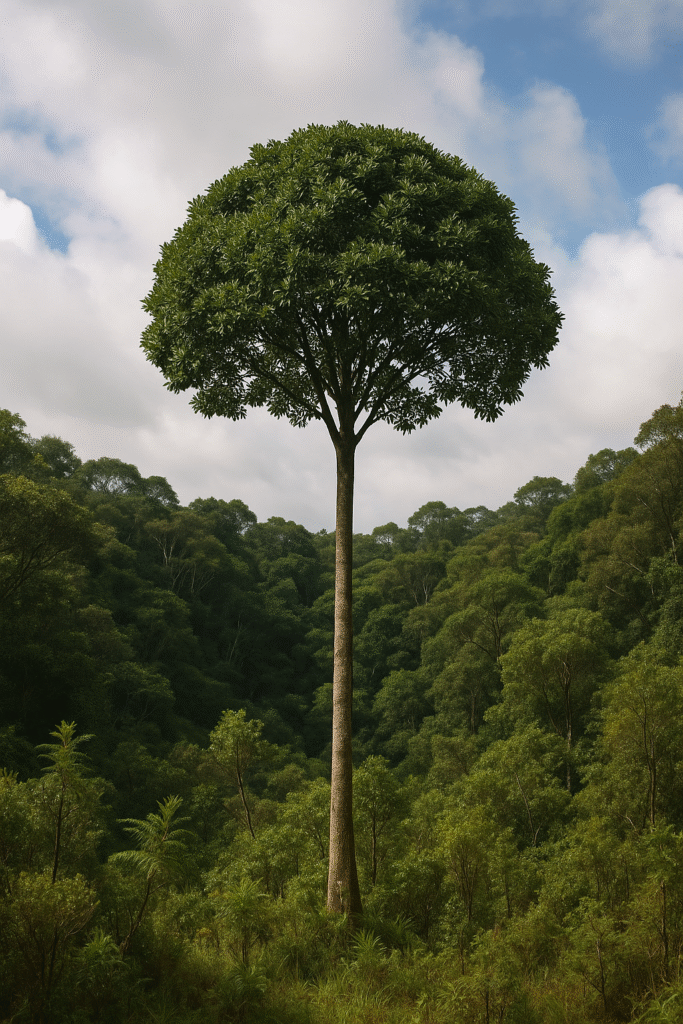Canela-sassafrás (Ocotea odorifera), also known as Brazilian sassafras, is a native tree of the Atlantic Forest and one of the most iconic species found in southern and southeastern Brazil. With its highly valued wood, aromatic leaves, and ecological importance, this tree is considered a true treasure of Brazil’s biodiversity. In this article, we explore everything about this fascinating plant—its features, uses, habitat, curiosities, and tips for those interested in growing it sustainably.
Characteristics of Canela-sassafrás
Canela-sassafrás is a perennial tree that can reach 10 to 25 meters in height in natural environments. Its trunk is straight, with grayish bark and simple, leathery leaves that are dark green and glossy on the upper side. The name “odorifera” refers to the characteristic aroma released by its leaves and wood, with notes reminiscent of bay leaf and cinnamon.
Its flowers are small and inconspicuous, usually white, and bloom in late spring. The fruits are small, oval drupes, highly appreciated by birds and wild animals.
Where It’s Found
Canela-sassafrás naturally occurs in the dense and humid forests of the Atlantic Forest, especially in the states of Paraná, Santa Catarina, São Paulo, and Rio Grande do Sul. It is endemic to Brazil, meaning it is not found in the wild anywhere else in the world.
Unfortunately, due to overharvesting and habitat destruction, this species is now listed as endangered. For this reason, the planting and sale of seedlings must follow specific rules and always come from legal, traceable sources.
Uses of Canela-sassafrás
Canela-sassafrás has many uses, both in industry and traditional practices:
- Wood: Its wood is resistant, durable, and easy to work with. It has long been used in fine carpentry, civil construction, and furniture making.
- Essential oil: Its leaves and wood yield safrole oil, which is used in perfumes, soaps, and even pharmaceuticals. However, safrole use has been restricted in several countries due to its potential toxicity in high doses and its illegal use in synthetic drug production.
- Traditional use: Historically, leaf infusions were used as digestives and mild sedatives, although such medicinal uses are now discouraged without professional guidance.
Fun Facts About Canela-sassafrás
- This tree is considered an ecological indicator, as its presence signifies well-preserved forest.
- The scent of its leaves is so strong that they were once used as a natural drawer or closet freshener.
- Canela-sassafrás belongs to the Lauraceae family, the same as true cinnamon (Cinnamomum verum) and bay laurel (Laurus nobilis).
How to Grow Canela-sassafrás
If you wish to grow this rare species and help in its conservation, it’s important to follow proper care guidelines:
Climate and Soil
Canela-sassafrás prefers a subtropical to tropical humid climate, with regular rainfall throughout the year. Soil should be fertile, well-drained, and rich in organic matter. Avoid compacted or waterlogged soils.
Light
While mature trees tolerate full sun, young saplings thrive best in partial shade, simulating their natural understory environment in the Atlantic Forest.
Watering
In the first months, keep the soil moist but never waterlogged. After the first year, the tree becomes more resistant to drought, especially when planted directly in the ground.
Fertilization
Apply organic fertilizer twice a year, especially in early spring and late summer. Earthworm humus, composted manure, and bone meal are excellent options.
Propagation
Canela-sassafrás is propagated by seed, which should be planted fresh—ideally right after fruit collection. Germination is slow and can take 30 to 90 days. The seedling grows slowly in the first few years.
Ecological Importance
In addition to its historical and economic value, Canela-sassafrás is vital to native wildlife, providing shelter and food for various bird and mammal species. Its preservation helps maintain the ecological balance of the Atlantic Forest.
Promoting the planting of native species like Canela-sassafrás is a powerful way to support environmental recovery and honor the rich botanical heritage of Brazil.
Conclusion
Canela-sassafrás is much more than a beautiful and aromatic tree—it’s a symbol of Brazil’s natural legacy and a call for urgent conservation. Growing this species is an act of respect for nature and an investment in a greener, more balanced future.
🪴 Shop Stunning Succulents at Leaf & Clay
Browse a curated collection of beautiful, healthy succulents delivered right to your door. Perfect for collectors and plant lovers!
Learn how Bidens pilosa thrives in all environments and why it’s valued in traditional medicine for its powerful healing properties.


